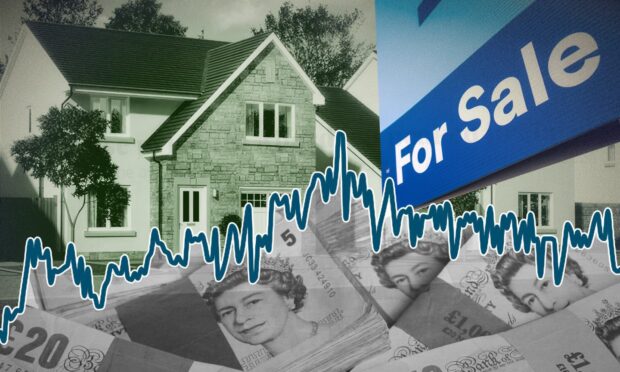At the height of the north-east oil boom house prices across the region were at an all-time high.
Properties peaked in Aberdeen before the impact of the oil price slump, which began in 2014, took hold.
Today’s average price of £165,065 represents a drop of 32.5% from the peak £244,638 in May 2015.
This means the average price in Aberdeen is currently at the same level as it was in May 2007.
Meanwhile, throughout Scotland property prices have soared during the last 17 years, according to figures from the Registers of Scotland.
New data has shown house prices have been decreasing across the Granite City, but increasing throughout the rest of Scotland.
A decade ago prices were soaring with one property expert recalling offers £100,000 over valuation still not being the highest bidder.
Aberdeen protected by ‘thriving oil and gas sector’
From 2015 the impact of the oil slump hit Aberdeen with thousands of jobs being lost in the sector. It affected the housing market hard.
The north-east had always been in “its own bubble” but things were about to change.
Alan Cumming, Aberdein Considine director, recalls the 2014/15 oil price crash “hitting hard”.
He said: “Those working in the property sector back in 2007 will recall the frantic pace of the market – a high proportion of properties selling at closing dates, three weeks on the market was a long time and offers well above asking price was the norm.
“The financial crash in 2008 did impact the north-east market but not to the same extent as the rest of the country.
“I remember it well and would say market activity cooled off before ramping up in 2010/11.”
Although the 2008 crash did affect the market it was nothing compared to the 2014/15 slump.
Property developers had been able to cash in on soaraway prices but that was about to change.
Alan said: “The north-east was very much in its own bubble, protected by the thriving oil and gas sector at the time.
“The oil price crash in 2014/15 hit the local property market much harder, combined with the policy changes in the lettings sector meant an influx of stock on the market with less demand as people relocated out with the city to find work elsewhere.
“Mortgage rates at the time were still traditionally very low which kept the market moving but not to the same degree and in general terms property prices in the north east gradually fell between 2015 – 2019.
“Moving home has not been on top of many people’s agenda combined with the political uncertainty and what that means for the energy sector in the north east has meant prices have flat lined.”
‘Bubble that had to burst’
At the peak of the market in July 2015 there were 519 transactions compared to 476 in July 2024.
Closing dates, offers well above valuation and properties only being on the market for days rather than weeks was normal.
Deborah Bonner, valuer at Gilson Gray, said: “On paper, the comparison in house prices between 2015 and today may appear stark, but if you scratch beneath the surface anyone will tell you that it was a bubble that had to burst.
“The extreme situation that buyers and sellers had to navigate 10 years ago was ultimately unsustainable and left many having to pay well over valuation at closing dates.
“For instance, I remember one client offering £100,000 over the valuation and still not being the highest bidder.
“Today, the property market is a much more level playing field and, while we might never see the types of prices we did in 2015 again, it is for the better.
“The last decade has been tough for Aberdeen, but there are many positives to focus on. House prices are starting to creep up as people have decided to carry on with their life plans, rather than waiting for a silver bullet to fix the economy.
“The arrival of Great British Energy in the city may also provide a boost, but even in the interim there is a healthy degree of activity in the property market.”
Market feeling ‘the chill of downturn’
Estate agent Savills recorded a 24% drop in residential property sales in 2016.
Inverurie, Banchory Aboyne, Ellon and Westhill all saw demand for properties rise as the market peaked.
Faisal Choudhry, Savills head of residential research in Scotland, said: “10 years ago we reported that property prices in the Aberdeen area were 25% above the ten-year average, while million pound plus sales here reached a record high in the year ending September 2014.
“The biggest issue for the market at that time was the lack of stock. Properties did not stay on the market for long as it was being fuelled by well-financed buyers, mostly employed within Aberdeen’s flourishing oil sector.
“Meanwhile, prime transactions in Aberdeenshire and Kincardineshire had almost doubled in the five-year period to 2014 and this phenomenon was driven by demand in the hotspots of Inverurie, Aboyne, Banchory, Westhill and Ellon.
“At that time, we were warning ‘Aberdeen’s housing market is inextricably linked to the vagaries of the UK oil and gas sector.”
It was just two years later the downturn hit and the market felt the force.
Faisal said: “Two short years later, in 2016, the true impact of Aberdeen’s oil-shock was reported in our research which noted a 24% fall in residential property sales.
“We said ‘Aberdeen has benefited from the warm glow of the oil market. The market is now feeling the chill of the oil market downturn’.”
Positive signs ahead
Despite the prices showing little progress from 17 years ago house types across Aberdeen and surrounding areas have seen an increase during the second quarter of this year.
Property prices in the city were up 3.1% in the second quarter of 2024, compared to the first quarter of the year.
Figures released by Aberdeen Solicitors Property Centre showed a total of 1,383 properties were sold through ASPC between April to June this year.
Laura Mearns, Northwood owner and director, said: “Whilst the data suggests a post-oil slump, it is far more nuanced.
“The market is undergoing a long-term adjustment to the new economic realities, alongside changing lifestyles, government policies and demographic shifts.
“Despite these challenges, Aberdeen’s housing market has shown resilience. The stability of the average house price and continued demand for smaller, affordable properties suggest that the market is adapting to the changing landscape.
“At Northwood, we are seeing small increases in prices compared to last year, and high levels of activity locally so there are certainly some positives to be had.”
We’ve been looking at the impact of the 2014/16 oil and gas slump in our Decade After Downturn series.
Check out these other stories such as:
How Aberdeen changed after oil price crash
Meet the Aberdeen events boss proving there’s life after oil and gas


Conversation